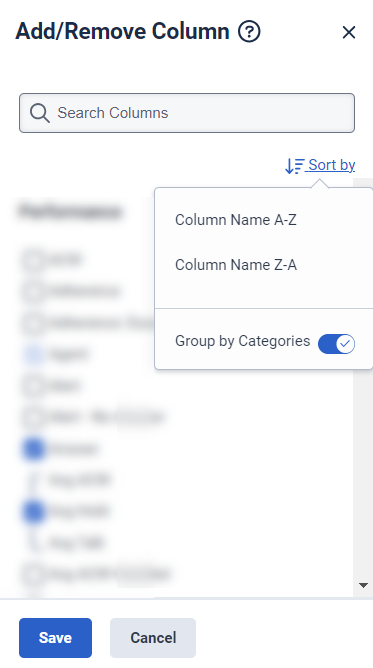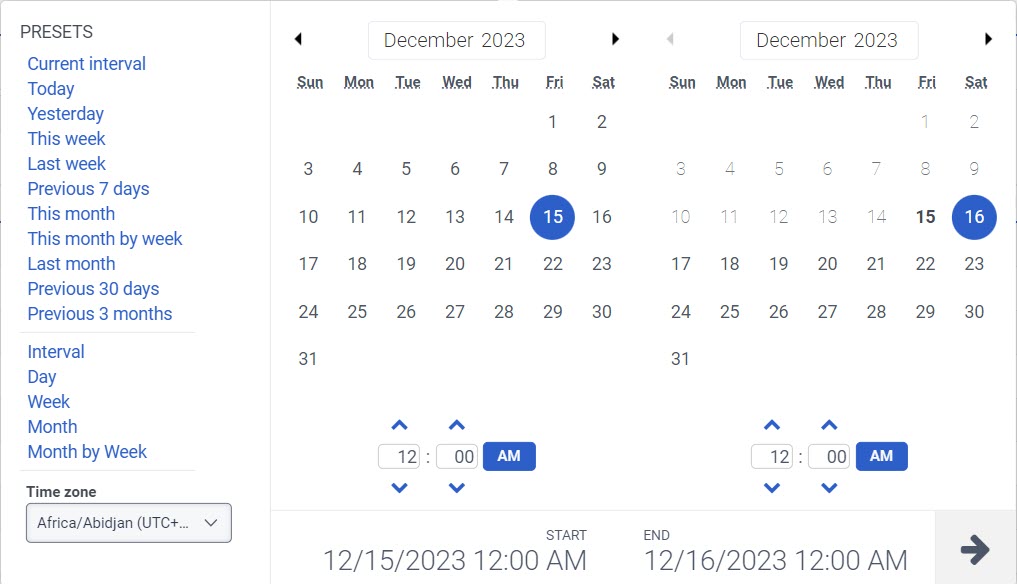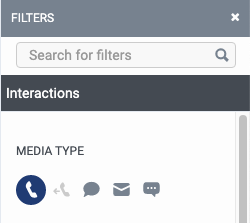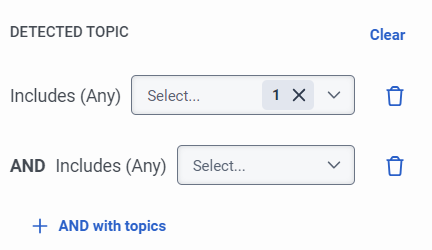Agent topics summary view
The following permissions:
- Analytics > conversation aggregate > view
- Speech and text analytics > topic > view
- Analytics > speech and text analytics aggregates > view
- UI > supervisor agent details > view
- Directory > user > view
- Groups > Work Team > View (to filter agent list by Work Team)
The Agents Topics Summary view displays current and historical metrics and data about agent topics. The data in the topic column changes in relation to the dates/times selected.
In the Agents Topics Summary view, you can view agent data (for example, Average Handle Time) and sentiment data (Average Sentiment Score, Negative Interactions, Negative Interactions %, Neutral Interactions, Neutral Interactions %, Positive Interactions, Positive Interactions %, Sentiment) distributed over time. Also, you can add topics of interest in columns, so that you can make a topic detection comparison between agents. You can hover over the Topic name column header to get information about the topic including Topic Name, Description, and Participants. By looking for outliers in specific topics, you can use this view to identify challenges between agents.
Available columns
To view the available columns, see the Agent topics summary view section in the View available columns in performance views by category article.
To view the consolidated list of available columns in the performance views, see Consolidated view of available columns in performance views.
To view the list of available columns in the performance views by category, see View available columns in performance views by category.
Set a default time zone in the workspace
You can set the default time zone in the analytics workspace before viewing any analytics view.
To set the default time zone in the workspace, follow these steps:
- Click Performance > Workspace.
- On the left side, from the Time zone drop-down menu, select the required time zone as the default time zone for the analytics workspace.
| To | Do this |
|---|---|
| Display the view | Click Performance > Workspace > Speech and Text Analytics > Agent Topics. |
| Filter by a collection of users, by name, division, group, role, or location | Click Filter User(s) in the top left corner of the screen For more information, see Filter by user or collection of users in the Customize the view section below. You can also combine this filter with an interaction filter. |
| Customize the view using interaction filters | Click Toggle Filters Panel in the top left corner of the screen. For more information about the available filters and columns, see the sections below. You can also combine the interaction filters with user filters. |
| Modify the columns that appear in the view | See Show, hide, and rearrange topic columns below. |
| Refresh the view | Click Refresh . The view updates automatically except when you use filters in the Filters pane. Refresh to display the most current data. |
| Save the view with your filter and column settings | Click Save . |
| Export the data in the view | Click Export . |
| Access the Agent topics detail view | Click an individual agent name. |
| Access the Agent performance views | Click the performance tab. |
View data for a group of agents
- Click Performance > Workspace > Speech and Text Analytics > Agent Topics.
- From the Agent Topics view in the Filter by agent(s) field, search for and select agents for which you want to see data.
- Next to the list of selected agents, click the View as a group option. Genesys Cloud displays the Agents Performance Detail view with aggregate data for the agents whom you selected.
- To save the view with your filter and column settings, click Save .
- To export the data in the view, click Export.
- To access the other Agents Performance views, click the other tabs.
Customize the view
To show only certain data, customize the Agents Topics Summary view using any combination of filters and by hiding, showing, or rearranging columns. For example, you can choose to show only certain columns or filter to see certain types of interactions. Your customizations remain as you navigate from view to view or leave and return to a view. You can also save your filter and column settings as a saved view to switch quickly between different data of interest in the same view.
More information about customizing the Agents Topics Summary view is available in the following sections.
To customize analytics views, use the date filter.
To filter metrics by date or configure a custom date range, use presets. When filtering metrics for this view, select any custom date range up to one year.
To use a preset to filter metrics, complete the following steps:
- To display the date filter, click the date.
- In the Presets list, select a preset date option.
Date presets
| Presets | Description |
|---|---|
| Current interval | Shows data for the current 30-minute time period. |
| Today | Shows data for the time period that includes the current interval. |
| Yesterday | Shows data for the previous day. |
| This week | Shows data for a Sunday through Saturday time period. |
| Last week | Shows data for the previous week, Sunday through Saturday. |
| Previous 7 days | Shows data for the previous seven days. |
| This month | Shows data for the current month, with no extra days. |
| This month by week | Shows data for the current calendar month starting on Sunday and ending on Saturday, including extra days if the month does not start on Sunday or end on Saturday. |
| Last month | Shows data for the previous calendar month with no extra days. |
| Previous 30 days | Shows data for the previous 30 days. |
| Previous 3 months | Shows data for the previous three months. For example, Nov 1, 2022 – Jan 31, 2023. |
| Interval | Shows data for a 30-minute time period. |
| Day | Shows data for a single 24-hour day. |
| Week | Shows data for a Sunday through Saturday time period. |
| Month | Shows data for the exact month with no extra days. If the current month is selected, you can see the data up to the current date. |
| Month by Week | Shows data for a calendar month starting on Sunday and ending on Saturday, including extra days if the month does not start on Sunday or end on Saturday. |
To use a custom date range to filter metrics, complete the following steps:
- Click the date to display the date filter.
- Select a start date and an end date on the calendar, and click the filter arrow .
To view data for a different time period using the same date presets, click the arrows on either side of the date display. ![]()
For example, to view data for the previous day, click the Day preset, and then click the arrow on the left side of the date.
To view data for a different time zone using the same date presets, from the Time zone drop-down menu, select the required time zone. You can create and save reports with the same selected time zone.
You can select the column header for the topic to see a distribution of that topic across the selected time period.
- When filtering you can select more than one media type. Click the relevant media type to select or deselect the type.
- You cannot select the voice and callback types at the same time.
- If you select voice, the callback option will be deselected. If you select callback, the voice interaction will be deselected.
- The available media types may vary from those shown above.
The selected media type icon is displayed above the column headers. For more information about various media types and their settings, see the Set behavior and thresholds for all interaction types section in the Create and configure queues.
Data in the view can be displayed in a chart. To view the chart, click the Show/Hide chart icon .
You can hover over the topic name column header to get information about the topic including the topic name, description, and Participants. With the topic information, you can gain an understanding of how the topic works and select the required topic.
To show or hide columns:
- Click the Pick columns icon on the right side. The Add/Remove Column pane appears.
- (Optional) To sort the columns in ascending or alphabetical order, click Sort by > Column Name A-Z.
- (Optional) To sort the columns in descending or reverse alphabetical order, click Sort by > Column Name Z-A.
- (Optional) To categorize or uncategorize the columns, click Sort by and enable or disable the Group by Categories toggle. Click the image to enlarge.

- Search or scroll to select the columns you want to view. Note: You can also use keyboard navigation to choose the columns.
- Click Save. The selected columns appear on the screen. Note: The column selections appear only after saving the changes and do not apply to the table immediately.
To rearrange the columns, click a column header and drag it.
To reset a view to default column settings, click Reset view to defaults ![]() .
.
You can select up to 20 columns.
For more information about the metrics shown in the columns, see the Available Columns section in this article.
To enter names of users you want to view, click the Filter user(s) search icon . Genesys Cloud populates the summary row with aggregate data about those users. You can filter by a User name, Division name, Group name, Work Team name, Role, or a Location. As you enter a name, the suggested names are displayed in the search results with the filtering type on the right. When entering a user name, you can also select the Reports to filtering type, to display the user's direct reports. You can continue to enter and select additional users to add to the view.
Filter by selecting multiple users
You can select multiple users to filter by.
- In the user's row, select the check box.
- Continue selecting user check boxes to add to filters.
- Click Add to filters.
To use the summary row to see aggregate metrics for multiple users, search for and select multiple users. The summary row then shows aggregate metrics for the selected users.
View aggregate data
To view aggregate data for several users, filter for multiple users and click View as group. Genesys Cloud displays the Agents Topics Detail view with aggregate data for the users that you selected. Use the Back arrow icon to return to the Agents Topics Detail view.
To filter the agent list by user type, in the top left-hand corner, choose any one of the required user types from the Active Users filter:
- Active Users (Default) – To filter only the active agents in the organization from the agent list.
- Inactive Users – To filter only the inactive agents in the organization from the agent list.
- Active and Inactive Users – To filter both the active and inactive agents in the organization from the agent list.
- Deleted Users – To filter only the deleted agents in the organization from the agent list.
Interactions filters
| Filter | Description |
|---|---|
| Detected Topic |
You can filter the data in the Agent Topics summary to view only interactions that contain certain topics, which allows you to perform a layering analysis of the interactions. By default, the Includes (Any) option is enabled. You can select single or multiple topics at the same level or different levels using OR/AND functions. When you add multiple topics at the same level, an OR is used between the topics. For example, if you add Topic A and Topic B to the first level under Includes (Any), the filtered data shows interactions where Topic A OR Topic B is detected. When you add Topics at different levels, an AND is used between the topics. For example, if you add Topic A to the first level using Includes (Any) and add Topic B to the second level using + AND with topics, the filtered data shows interactions where Topic A AND Topic B are detected. |
| Message Type | The ACD message type used. Genesys Cloud currently supports the following message types: Facebook, Line, Open, SMS, Twitter, Web Messaging, and WhatsApp. |
| From | Displays information for interactions sent from the selected email addresses.
|
| To | Displays information for interactions sent to the selected email addresses.
|
| ANI | Displays interactions with the selected ANIs.
|
| DNIS | Displays information for interactions with the selected original DNIS number. This DNIS number was dialed at the beginning of the interaction.
|
| Direction | Displays information about interactions of the selected directions. Whether the interaction was inbound, outbound, or inbound/outbound. |
| Queue | Displays interactions associated with the selected queues. |
| Flows | Displays interactions associated with the selected IVR flows. |
| Flow Version | Displays interactions associated with the selected IVR flow version. |
| Conversation Duration | Displays interactions of the selected duration. To search for interactions of a custom duration, select the timeframe and use the controls to set the duration:
|
| Total Handle | Displays interactions of the selected total handle time. To search for interactions of a custom total handle time, select the timeframe and use the controls to set the duration:
|
| Wrap-Up | Displays interactions that have the selected wrap-up codes. |
| Participant |
Displays information about the type of participant including Internal, External, or All. |




